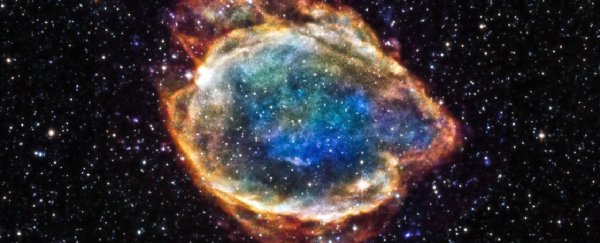Multiple star systems are very common in the Milky Way. While most of these systems are binary systems consisting of two stars, others contain three, four, or even six stars.
These systems tend to be pretty stable since unstable systems tend to break apart or merge fairly quickly, but sometimes you can get a kind of meta-stable system. One that lasts long enough for stars to evolve while still being stable in the end. And that end could be a supernova.
It all comes down to gravitational dynamics. In Newtonian physics, two orbiting masses in isolation are always stable. The only paths they can have are elliptical orbits. This is why simple binaries are the most common multiple star systems.
Once you have three or more masses, things get more complicated. So complicated that there isn't an exact solution to the three-body problem, much less four or more.
Fortunately, we can make highly accurate orbital models. So while we don't have an exact solution for multiple star systems, if we make precise measurements of the stellar motions we can create an accurate model.
These models are so accurate that they'll make good predictions across millions of years. This leads us to an interesting star system known as HD 74438.
It was discovered in 2017 by the Gaia-ESO Survey, and it is what's known as a spectroscopic double binary. This means Gaia's telescopes aren't powerful enough to observe individual stars, but we know they are there because of their stellar spectra.
As the stars orbit around each other, each star's spectra Doppler shifts slightly because of their relative motion. So we can calculate their motion and speed.
 The orbital motions of HD 74438. (University of Canterbury, Mt John Observatory)
The orbital motions of HD 74438. (University of Canterbury, Mt John Observatory)
In a recent article in Nature Astronomy a team used ground-based spectroscopic observations of HD 74438 to pin down the orbits of the four stars.
They confirmed that the stars are in a 2 + 2 configuration, where the stars are paired up into close orbiting binaries which slowly orbit each other. But their measurements were precise enough to show that the slightly gravitational tug of the outer binary is making the inner binary unstable.
HD 74438 is still very young. It is part of an open cluster known as IC 2391, which is only 43 million years old. The stars are all of a similar mass to the Sun, so they will have similar lifetimes.
Given enough time, the stars are likely to end their lives as white dwarfs. And since the gravitational instability of the system is small, the stars could live long enough to become white dwarfs. But their orbits would still be unstable, and that could cause them to collide in the end.
That's where things get a bit interesting because the HD 74438 is a perfect example of how a multiple star system could evolve to create a merger of white dwarfs.
White dwarf mergers are one way that Type Ia supernovae occur. These supernovae play a central role in our measurements of cosmic expansion. Multiple star systems such as HD 74438 could be a primary cause of Type Ia supernovae.
While double binaries only make up a small fraction of multiple star systems, this study shows they can often be in an unstable long-term relationship.
The research has been published in Nature Astronomy.
This article was originally published by Universe Today. Read the original article.
